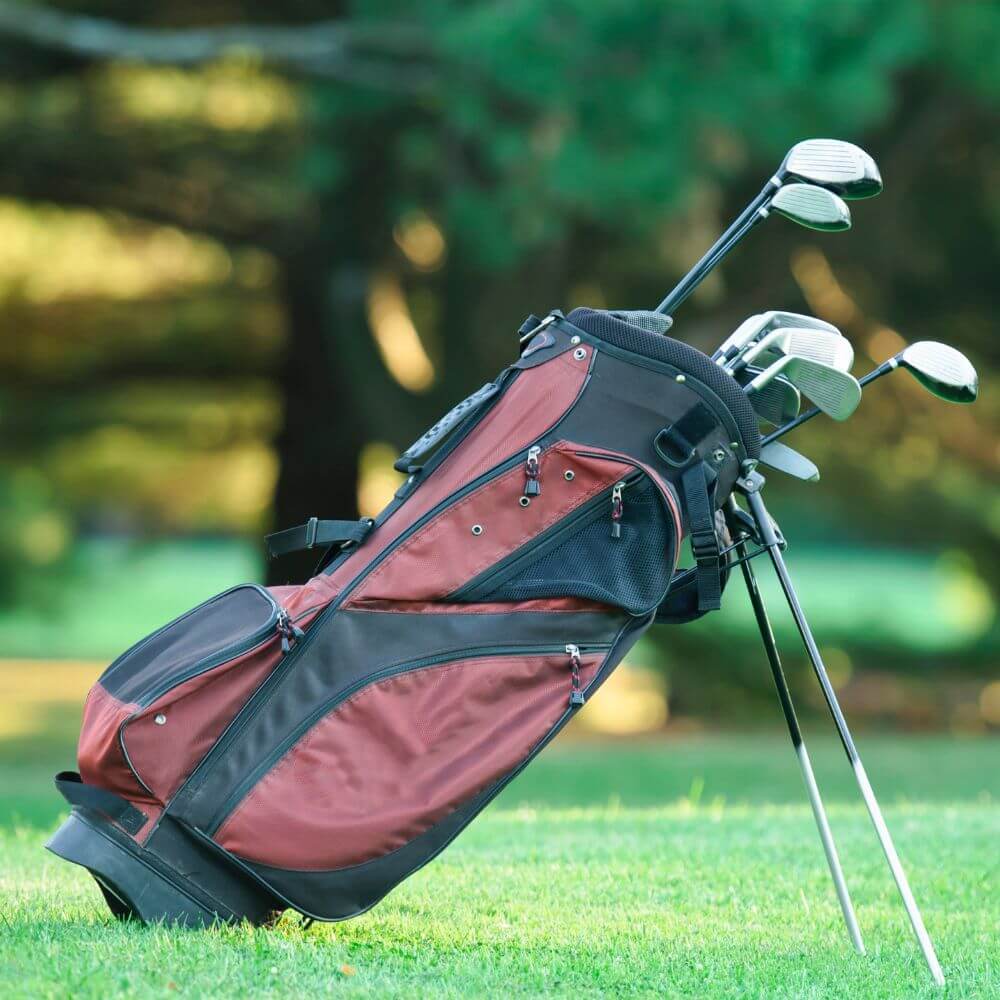Content Summary
Introduction
Golf is a highly strategic, individual sport that requires skill and patience to master. As such, it’s important for golfers to know exactly what clubs they need for the best performance on the course.
The maximum number of clubs a golfer can carry in their bag at one time is 14. Although specific golfers may choose to add more than 14 clubs to their bags, the USGA rule governing golf states that only 14 can be used during play on the course. In case you were wondering, there is no limit with a golf ball. You can carry as many as you like.
Knowing which clubs you carry in your bag and when to use them can help you get the most out of your game, whether you’re a beginner or an experienced golfer.
Generally, most golf bags will include at least three woods – driver, fairway wood and hybrid/rescue – plus several irons as well as wedges and putters. Some golfers also choose to substitute a long-iron with additional hybrids and multiple short-irons or wedges instead of carrying a full set of irons from 2-iron through 9-iron.
Maximum Number of Clubs
How many golf clubs you can put in your golf bag is limited by the rules of golf. According to the rules, a golfer is only allowed to carry a maximum of 14 clubs in their bag. As such, it is important for golfers to familiarize themselves with the regulations when it comes to carrying clubs.
USGA Rules
The United States Golf Association (USGA) and the Royal and Ancient Golf Club of St. Andrews work together in setting certain rules pertaining to golf. 14 clubs may be carried in a golfer’s bag at any one time. Although there is no law dictating the exact make-up of these 14 clubs, the most common sets includes:
- Driver
- 3 wood
- Hybrid
- 5 Iron through Pitching Wedge
- Sand Wedge
- Putter
For golfers who choose to bring more than 14 clubs, they will incur a 2 stroke penalty for each hole played with the additional club(s) in the bag. If they want to take the extra clubs out of play they must follow USGA Rule 4.1c. Also you will find in this rule section about your playing partner's golf clubs and how that can affect you.

Professional Golfers
Professional golfers often carry between 11 and 14 clubs in their golf bags, depending on the individual golfer's playing style and preferences. Most professional golfers use a driver, two to four woods, two hybrids or fairway woods, seven irons (1-4, 5-9 for multiple players), and either a pitching wedge or an additional sand wedge. As an example, the Tiger Woods' tour bag usually consists of 10 clubs:
- three woods (driver, 3 wood & 5 wood)
- four wedges (pitching wedge, 52-degree gap wedge, 56-degree sand wedge & 60-degree lob wedge)
- three irons (2 iron, 3 iron & 4 iron)
For amateur players who are looking to maximize their ability on the course while minimizing the number of clubs they have in their bag, as well as avoiding carrying too much weight around the course during a round of 18 holes; most recommend carrying no more than 10-12 clubs in order to ensure that they are fully utilizing all of the clubs that are in their bag.
Experienced Players
These players may choose to further customize their set with a wider selection spanning fairway woods/hybrids (1-3), longer irons such as 4 or 5 irons, maybe even a 3 iron, and specialized wedges like lobs and sand wedges – all totaling 14 clubs within the permitted maximum. Some choose to use the same golf bag and switch out clubs or have a different golf bag with a different set of clubs.
Amateur Golfers
According to both the Rules of Golf and certain Amateur Status considerations, amateurs competing in sanctioned tournaments are only allowed to carry a maximum of 14 clubs in their bag. This limit was imposed by the United States Golf Association (USGA) in order to prevent “equipment advantages” that could occur if players carried an excessive number of clubs.
Every golfer carries a bag of golf clubs, though the exact set will vary based on personal skill and preference – as well as playing conditions. The most common combination for an amateur golfer is 14 clubs including woods, hybrids, irons, wedges, and putter – in addition to a driver.
Typical club sets for beginners or high handicap players would include:
- Driver
- 5 wood
- 3 hybrid or long iron
- 5-9 irons
- PW & SW wedges
- Putter
Examples of this type of set can range from 10 pieces total (less choice but cheaper) up to the 14 total golf clubs allowed (more choice but more expensive).
Recommended Number of Clubs
When playing golf, it is important to have the right amount of clubs in your golf bag. While the amount of clubs you should carry will vary depending on your skill level, there is a general guideline for the recommended number of clubs to have in your bag.
Drivers
Drivers are the most iconic club in golf, and they come in a variety of shapes and sizes. Most golfers carry between one and two drivers. While many golfers enjoy having multiple driver options to choose from, the beginner golfer typically only needs one driver if they're just getting started.
Drivers are ideal for long-distance drives off the tee and can typically help create more loft and control the distance of your shots. If you’re looking for extra trajectory on your drives, you might want to look at purchasing a low loft or larger head driver.
Irons
Irons are perhaps the most important clubs in the golf bag because they are used to hit a variety of shots. The majority of golfers carry eight irons, ranging from the three iron through to the pitching wedge. This includes four hybrid clubs, such as utility or rescues, that cover three through six and/or seven sometimes.
It is recommended to carry two wedges – a pitching and sand wedge – along with up to seven different hybrids/irons. It is important to pick hybrid/irons that best fit your swing style so you can deliver consistent performance on approach shots.
Wedges
Wedges are an important and versatile club in the game of golf, and an important resource when you’re playing on a challenging golf course. Depending on your level of play, a golfer is usually recommended to carry 4-5 wedges in their bag. High handicappers are better off using 2 wedges.
The four main types of wedges typically found in the bag are:
- Pitching Wedge (PW)
- Approach Wedge (AW)
- Sand Wedge (SW)
- Lob Wedge (LW)
The Pitching Wedge is designed to be used from distances out to a hundred yards or so while the Approach wedge is designed for somewhat shorter distances. The Sand Wedge helps players get out of sand traps without much trouble and for chipping, while the Lob wedge has been designed for higher trajectory shots around tight greens to stop without to much rollout.
Many professional golfers will also opt for additional Gap or Utility wedges which lie between PW and LW. The sole purpose of having these wedges is that they provide better finesse shots while hitting from different distances around the green. Depending on your level of play, determine if additional wedges may enhance your setup.
Lastly, your club selection should also be based upon what type golf course layout you’ll be playing. If a particular course is full of water hazards or rough areas then one might opt for wedges that can be used to launch higher shots to get over these types of hazards.
If your on courses that present more sand bunkers as obstacles then to help navigate effectively around those areas a sand wedge would be more of a necessity. Just remember not to carry too many clubs.
Putters
Putters are designed to help golfers make shots on the greens to get the ball rolling on a path to the cup. Putters typically have flat faces and are slightly heavier than irons or woods and consequently provide increased accuracy for shots on the green.
The optimal number of putters for golfers depends on their playing style and skill level.
- For pros and very advanced amateurs who only use one type of putting stroke, one putter can suffice, although most professional golfers have multiple putters with different lengths and sizes of shafts to accommodate their changing needs over the course of playing multiple rounds.
- For beginners or recreational players with frequent changes in their putting style throughout a round, having a putting lesson or two would be beneficial in understanding how to properly putt and sink more putts during a round.
- Having a couple of putters to choose from also adds extra options in your bag while letting you take out some lengthy irons if needed since long irons are not as widely used now as they were in the past due to advances in technology with hybrids which has increased distance and accuracy with these clubs.
Conclusion
When it comes to how many clubs in a golf bag can you carry, the answer is that the exact number for clubs depends on an individual’s personal game and play style.
An amateur will set up his or her bag with a maximum of 14 clubs as required by The Rules of Golf, composed of irons, woods and a putter.
Professional and advanced amateurs will tweak their bags according to what type of courses they usually play on, weather conditions and other factors that affect their play. They generally carry fewer clubs.
A maximum 14 clubs are allowed as part of The Rules of Golf and may not be exceeded except in certain cases (eg: during practice sessions). Remember that golfers should take care to ensure that their bag stays organized and up-to-date with the latest clubs allowing them to perform better!
Thank you for visiting, and we hope to see you back soon!








